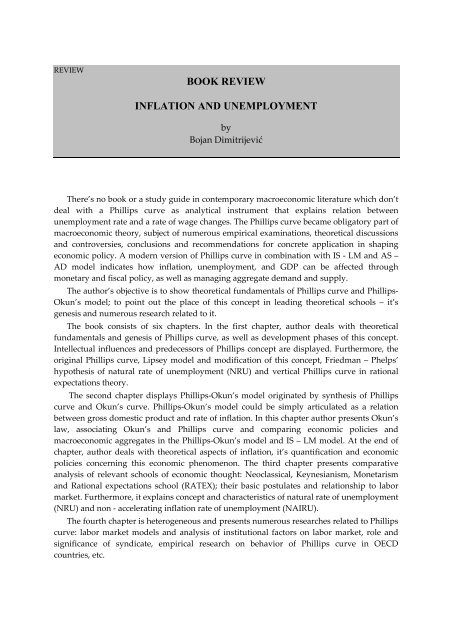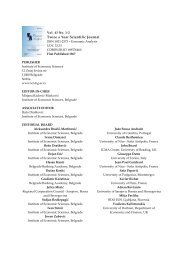BOOK REVIEW INFLATION AND UNEMPLOYMENT
BOOK REVIEW INFLATION AND UNEMPLOYMENT
BOOK REVIEW INFLATION AND UNEMPLOYMENT
You also want an ePaper? Increase the reach of your titles
YUMPU automatically turns print PDFs into web optimized ePapers that Google loves.
<strong>REVIEW</strong><br />
<strong>BOOK</strong> <strong>REVIEW</strong><br />
<strong>INFLATION</strong> <strong>AND</strong> <strong>UNEMPLOYMENT</strong><br />
by<br />
Bojan Dimitrijević<br />
There’s no book or a study guide in contemporary macroeconomic literature which don’t<br />
deal with a Phillips curve as analytical instrument that explains relation between<br />
unemployment rate and a rate of wage changes. The Phillips curve became obligatory part of<br />
macroeconomic theory, subject of numerous empirical examinations, theoretical discussions<br />
and controversies, conclusions and recommendations for concrete application in shaping<br />
economic policy. A modern version of Phillips curve in combination with IS - LM and AS –<br />
AD model indicates how inflation, unemployment, and GDP can be affected through<br />
monetary and fiscal policy, as well as managing aggregate demand and supply.<br />
The author’s objective is to show theoretical fundamentals of Phillips curve and Phillips-<br />
Okun’s model; to point out the place of this concept in leading theoretical schools – it’s<br />
genesis and numerous research related to it.<br />
The book consists of six chapters. In the first chapter, author deals with theoretical<br />
fundamentals and genesis of Phillips curve, as well as development phases of this concept.<br />
Intellectual influences and predecessors of Phillips concept are displayed. Furthermore, the<br />
original Phillips curve, Lipsey model and modification of this concept, Friedman – Phelps’<br />
hypothesis of natural rate of unemployment (NRU) and vertical Phillips curve in rational<br />
expectations theory.<br />
The second chapter displays Phillips-Okun’s model originated by synthesis of Phillips<br />
curve and Okun’s curve. Phillips-Okun’s model could be simply articulated as a relation<br />
between gross domestic product and rate of inflation. In this chapter author presents Okun’s<br />
law, associating Okun’s and Phillips curve and comparing economic policies and<br />
macroeconomic aggregates in the Phillips-Okun’s model and IS – LM model. At the end of<br />
chapter, author deals with theoretical aspects of inflation, it’s quantification and economic<br />
policies concerning this economic phenomenon. The third chapter presents comparative<br />
analysis of relevant schools of economic thought: Neoclassical, Keynesianism, Monetarism<br />
and Rational expectations school (RATEX); their basic postulates and relationship to labor<br />
market. Furthermore, it explains concept and characteristics of natural rate of unemployment<br />
(NRU) and non - accelerating inflation rate of unemployment (NAIRU).<br />
The fourth chapter is heterogeneous and presents numerous researches related to Phillips<br />
curve: labor market models and analysis of institutional factors on labor market, role and<br />
significance of syndicate, empirical research on behavior of Phillips curve in OECD<br />
countries, etc.
24<br />
Economic Analysis (2009, Vol. 42, No. 3-4, 91-94)<br />
In the fifth chapter author examines economic system of Yugoslavia, assessing empirical<br />
and theoretical research of inflation, unemployment and GDP in the period between 1956<br />
and 1990. Moreover, this chapter provides a review of economic literature which is dealing<br />
with Phillips and Okunʹs curve and an attempt of creating empirical foundations of these<br />
two theoretical concepts in Yugoslavian economic system.<br />
In the sixth chapter author is analyzing contemporary research of Phillips curve and its<br />
implementation in modern concepts of macroeconomics and economic policies. In this<br />
chapter following issues are elaborated: hysteresis as an answer of New Keynesianism,<br />
alternative hysteresis theories, relation between adaptive and rational expectations, Lucas<br />
supply function and Lucas critiques, implementation of Phillips curve in welfare economics<br />
and game theory, analysis of Phillips curve in developing and transition countries; with<br />
special interest in behavior of Phillips curve during stagflation period from 1980 to 2000.<br />
As a supplement to this book, author presents his empirical research about possibility of<br />
existence of Phillips curve in Yugoslavian economy in the period between 1982 to 1990.<br />
The book contains numerous contemporary methods, a number of charts and<br />
spreadsheets, and portrayal of basic relations of Phillips curve and macroeconomic models.<br />
Author used voluminous literature and a great number of empirical researches related to this<br />
topic. A vast number of statistical and econometrical methods, as well as comparative<br />
analyses of myriad scientific papers, theories and economic schools are employed.<br />
The author is trying to find an answer for the following basic question: Could Phillips<br />
curve be used as an economic tool in macroeconomic policy? By using relatively modest<br />
econometric methodology, he gets to the right conclusion that Phillips curve is not applicable<br />
in Yugoslavian economy and couldn’t be used as useful theoretical instrument in<br />
macroeconomic policy.<br />
The book is logically structured with valid conclusions. On the basis of presented<br />
analysis of Phillips curve, its reflection on contemporary economic schools, comparative<br />
analysis of leading theoretical schools – as well as analysis of labour market – it presents<br />
useful and current macroeconomic study guide for economists, academics, researchers,<br />
business people and students.<br />
Lovre Ivan, Perić Mladen<br />
University EDUCONS, Faculty for business economics, Sremska Kamenica
















